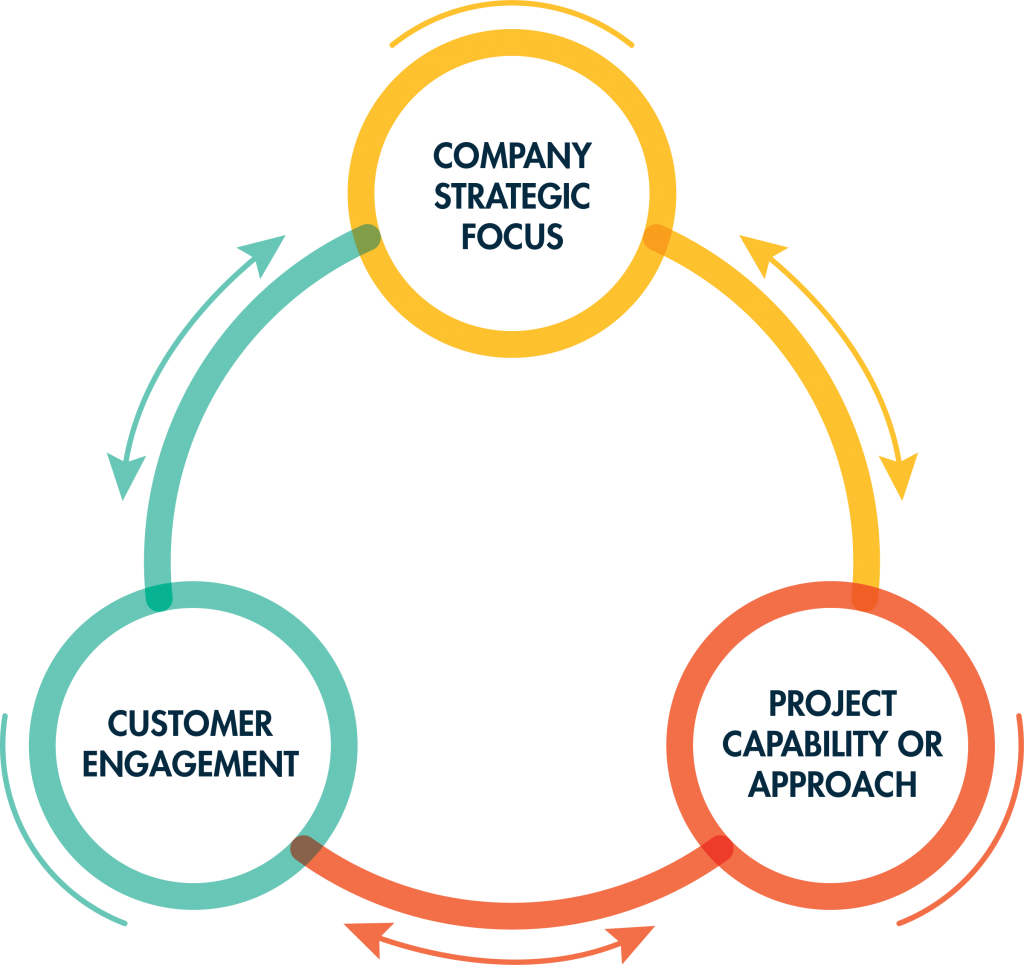Playing to Win: How to Drive Growth Through Differentiation

Differentiation is all about value, which represents those things that a customer is willing to pay a bit more for.
Thinking about differentiation is a bit like the thinking that goes into the game of football. On the surface the concept is simple—advance the ball downfield to score. Once you successfully reach the end zone, you kick a field goal for an extra point; or if you really want to take a risk, run or pass for an extra two points.
Company differentiation is a similar concept: Moving downfield is a lot like the project pursuit process in the industry. It requires a lot of sweat, effort and energy to weave in and out of the competitors who also want to gain control of the football. Is it better to pass or run the ball? What is the best way to leverage the talent on the team? What will competitors likely do to regain control of the football?
In football, scoring a touchdown is great. It’s the equivalent of winning the first project with the client. But just like football, you do not want to stop there. You need to go for the point after. In construction that means getting set up to win the second, third, etc., project with that same client. You want to set yourself up for more “points” with that client.
Differentiation means to stand out in ways that will make the customer pick you, preferably at a premium price, over other qualified competitors. Simple. The challenge is pulling that off successfully, project after project.
So What Is Differentiation Really?
Differentiation is all about value, which represents those things that customers are willing to pay a bit more for. It is something that helps them advance their goals and objectives in a beneficial manner. It is all about the customer, not the contractor. Differentiation happens in the customer’s mind; not only is it something the customer values and will pay a bit more for, but also it must be something that your competitors are not (or can’t) deliver consistently.
Sometimes customers value different things than we do. Because the customers are paying for the “difference,” they get to choose what does and doesn’t have value. Differentiation might be one large thing, or, more likely, it is layers of points of value that add up to positioning you over the competition.
Right now industry firms are scrambling for ways to stand out and be different. There will likely be a rush to the bottom as some competitors—short on work—cut their prices to win work. Price is always a part of the selection process. If value doesn’t stand out clearly among competing firms, then price will be the differentiator that wins the work.
Some customers disproportionately value price over anything else. If price alone is the name of the customer’s game, make a good business decision to pursue or not. If you want to play that game, you know the rules—find strategies that allow you to get low and still make money. We will talk about a company-level strategy, built on efficiency, that allows contractors to compete on price and yet win on their bottom line.
If the sole selection criterion is price, go in with your eyes wide-open. Take as much cost out of the pursuit and construction process as is feasible to deliver the required quality and safety. If you do not want to play that game, walk away before investing a lot of time and energy chasing the work.
Creating or Establishing Layers of Differentiation
Differentiation comes in many layers. For example:
- You might be highly differentiated from competitors in one market segment, yet not in others.
- You might easily differentiate from midsize competition, yet when competing with larger companies, find yourself in a commodity position.
- You might be strongly differentiated in a market segment, yet given what a competitor is likely to offer on a specific project pursuit, you are back on the football field with the need to call an audible to change the planned play on this down.
That is part of the nuance of differentiation. In a general sense, differentiation comes from:
1. Company-level strategic focus
2. Customer engagement and expectations
3. Project approach and capability

1. Company-Level Strategic Focus
A company’s point of view about the future is the first frame of differentiation. It is not that a vision of “being the best in the industry” sets you up for differentiation; rather it is the approach to “how” you become the best that sets you up to be different. Stepping back and looking at the range of ways companies position themselves, it comes down to a continuum or line they move across. Strategic focus ranges from best in class to transformative. For simplicity, we will talk about these two ends of the strategy continuum, skipping over the stops in between.

Companies with a strategic focus to be best in class win based on their operational effectiveness. They also:
- Cut cost out of the system by being efficient.
- Study and implement industry-leading practices.
- Embrace prefabrication to gain the on-site efficiency of installation.
- Leverage handheld technology to streamline reporting and gain real-time cost projections.
- Use drones to decrease the time it takes to conduct rooftop inspections.
- Look to stay ahead of the curve and provide options to customers that drive overall project efficiency and performance.
Let’s look at technology when considering differentiation. Being the first one to adopt a new technology might provide short-lived differentiation, but that ends when your competitor buys the same thing. The real advantage comes from connecting capabilities and results that can be achieved through technology, not the technology itself. It is not what it “is,” it is what it “does.”
Similarly, when the U.S. Green Building Council first came out with LEED accreditation, it was a differentiator. You had accredited people and your competitors did not. The capability has quickly been absorbed. In some market segments, on larger-sized projects, having accredited people is an expectation. It is no longer a differentiator. Regardless, it is what the capability does for the customer and the project that sets it up to be a differentiator or not.
Companies that position on transformation position to win on innovation. They are looking for the next amazing thing to bring to their customers and projects. They also:
- Provide a unique level of company-owned equipment on a marine project, knowing other competitors will be constrained in their ability to access it in the open market.
- Are sophisticated with using technology that allows the company to have a central war room where construction can be monitored and supported real time.
- Use augmented reality goggles to “walk” customers through a completed site to give them control over changes before construction even starts.
- Incorporate nanotech in the PPE (personal protective equipment) of tradespeople to monitor their health and safety.
All of these are in use in the industry today. All are unique approaches that are slowly being absorbed into what all competitors provide to customers.
A company’s strategic focus will impact what it values and stands for. It impacts how employees approach working with clients and engaging their people and trade partners. It impacts how, and if, they engage in the industry and their communities. In short, it impacts how they show up in all they do.
2. Customer Engagement and Expectation
Customer-level differentiation comes from how you engage with your customers and what solutions you offer. You can differentiate based on customer experience; customers will value that experience and be willing to give you an advantage in selection and perhaps price. It is a bit easier to sell this to existing clients who have experienced the difference, versus a new customer whom you just are getting to know.
You might stand out by having deep knowledge of your customer’s unique expectations, budgetary limitations or risk posture, or maybe there is something that you incorporate regarding its business purpose for the project. For example, years ago, I worked with a team specializing in hospital projects that focused on driving safety. After dealing with issues related to impractical hospital design, the team added a hospital safety designer and found several opportunities to improve safety and patient outcomes in the overall design. For a manufacturer concerned about getting its product to market quickly, you might come up with a way to cut two months off the construction process or turn over its plant’s operational parts earlier than expected. The key is to get creative and see the world from the customer’s perspective.
Remember that to qualify as differentiation, the value you bring to the table must be something that your competitors are not or cannot provide easily or consistently. You will want to match many of the ideas and solutions offered by competitors just to stay in the game. In other words, when looking for differentiators, it must be something that makes you stand out from competition in ways that are meaningful to the customer.
3. Project Approach and Capability
Differentiation also comes from the project itself and how you approach design and/or construction, project kickoff and turnover. It might be as straightforward as taking a different approach to a medical office building (MOB) renovation because you constructed the original building and know a thing or two about the soil conditions. Here are a few other differentiators that you may not even know you have:
- What about your use of project technology that allows greater communication with the customers’ end users that can save them time and energy?
- Does your approach to risk management on-site provide the client with a business advantage that helps deliver greater value for his/her customers?
- What different materials could you use to drive lifetime value to your customer?
- What about your team’s unique experience and depth?
For example, one contractor differentiated itself at an engineering college by incorporating its construction project and progress into the engineering curriculum. Hiring a team to film the project, challenges and approaches became a real-time learning lab that professors used in their classrooms. The plans, monthly updates and schedules became teaching tools. The superintendent served as a guest lecturer and talked about the difference between design and constructability. If the college had a media or arts program, project filming might have provided another opportunity to leverage the construction project into a real-time learning opportunity.
Raising the Bar
Like football, being successful at differentiation requires strategy and action. It is not static. You need a game plan as a company and as a team. You need to run different plays, depending on risk, project complexity and available talent while also considering who the customer and competitors are. Differentiation is nuanced, situational and multifaceted.
Keep asking yourself:
- Does this add meaningful value to the client, or is it simply an expectation due to the type, size and complexity of the project?
- What do we have to do to ensure that we deliver 100% on our promises?
- How does the customer look at this project/situation differently than we do?
- What can we do to demonstrate our difference and the value it adds?
Being a differentiator means adding value for the client. Meaningful value generates meaningful differentiation. With construction firms clamoring for projects, having the necessary capabilities to complete a project is not enough. Understanding the client’s needs on a project, no matter how many similar projects a firm has under its belt, will drive the firm to satisfy the customer, fostering a positive relationship based on trust and understanding.



